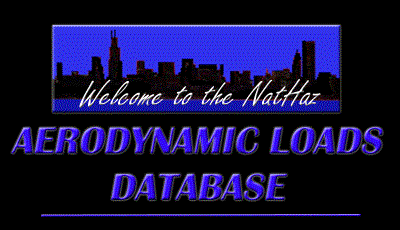

NOTE:
This material is based upon work supported by the National Science Foundation under Grant No. 0085019.
Any opinions, findings, and conclusions or recommendations expressed in this material are those of the author(s)
and do not necessarily reflect the views of the National Science Foundation.
DISCLAIMER:
The information in this database is not necessarily intended to be used in lieu of wind tunnel testing, particularly for dynamically sensitive structures, but rather provides
a valuable tool for preliminary design.
The NatHaz Aerodynamic Loads Database version 1.0 was established in the Fall of 2000 to provide the community access to wind tunnel test data for the determination of response quantities in the alongwind, acrosswind and torsional directions. Although the alongwind response can be determined through analytical procedures readily available in codes and standards worldwide, most codes and standards provide little guidance for the critical acrosswind and torsional responses. This is partially attributed to the fact that the across-wind and torsional responses, unlike the alongwind, result mainly from the aerodynamic pressure fluctuations in the separated shear layers and the wake flow fields, which have prevented, to date, any acceptable direct analytical relation to the oncoming velocity fluctuations. However, it has been recognized that for many high-rise buildings the across-wind response may exceed the along-wind response in terms of both serviceability and survivability design requirements (e.g., Kareem 1985), necessitating careful consideration of these response components. As a universal analytical approach is lacking for the acrosswind and torsional response, wind tunnel measurements have served as an effective alternative for determining loads for these response components. As opposed to providing empirical expressions for the acrosswind and torsional load spectra as a function of aspect ratio, as done previously, the internet now allows measured spectra to be distributed, avoiding any errors associated with curve-fit approximations.
This site serves as an important first step in establishing an online experimental database for use in the preliminary design of tall buildings. The interactive database will provide users with the value of the RMS base moment coefficient and the non-dimensional power spectrum resulting from force balance measurements on rigid models. The experimental data is available for all three response components and a series of structural shapes of varying dimension under two classes of wind conditions. This data, in conjunction with the procedure provided herein, will permit the user to determine the base bending moment on the structure, and then proceed with the desired response analysis (Zhou et al. 2003). As a result, NatHaz Aerodynamic Loads Database was recently introduced in the Commentary of ASCE 7-05 (C6.5.8) as an alternative means of assessing the dynamic wind load effects on high-rise buildings.
The recently re-designed NatHaz Aerodynamic Loads Database version 2.0, integrating the latest advances in data management and mining for interactive queries of aerodynamic load data and an integrated on-line analysis framework for determining the resulting base moments and equivalent static wind loads (ESWL) for survivability and accelerations for serviceability (habitability) as linked in On-Line Design menu. The key feature of the new version is the flexibility its analysis module offers: users may select not only the data from the on-line NatHaz Aerodynamic Loads Database, but also may implement any arbitrary power spectral density (PSD) expression or wind tunnel-derived PSD data set for the evaluation of wind load effects on high-rise buildings. Thus it serves as a stand-alone analysis engine with its user-friendly analysis interface, which will be particularly useful for those who may not be very familiar with the details of the random vibration-based dynamic analysis procedure generally used in connection with HFBB measurements. The NatHaz Aerodynamic Loads Database version 2.0 is robust in that it can and will include additional data sets with more refined spectral resolution and ranges of reduced frequency to yield a comprehensive, simplified and efficient platform for e-analysis of high-rise buildings based on HFBB (Kwon et al. 2008).
If you have any questions or comments about the content of this site,
please e-mail to Dr. Ahsan Kareem, Dr. Tracy L. Kijewski-Correa or Dr. Dae-Kun Kwon